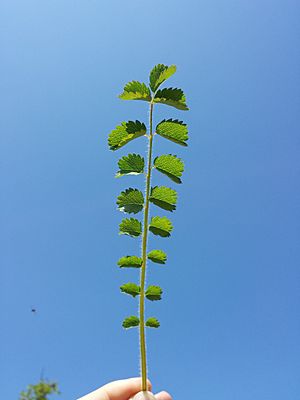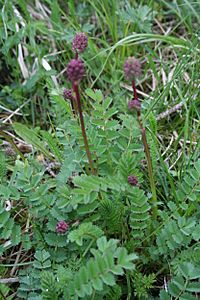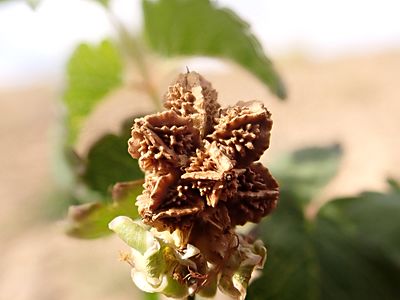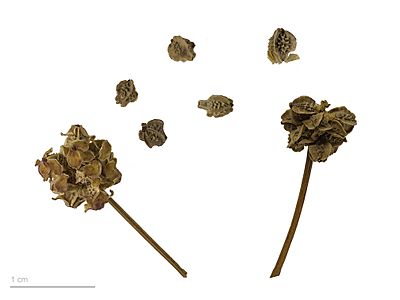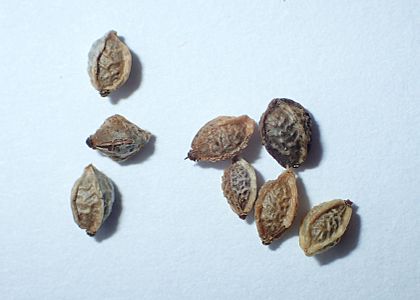Salad burnet facts for kids
Quick facts for kids Salad burnet |
|
|---|---|
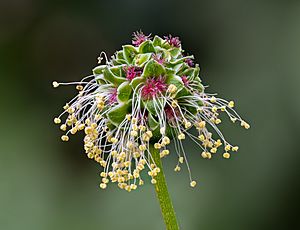 |
|
| Male flower | |
| Scientific classification | |
| Genus: |
Sanguisorba
|
| Species: |
minor
|
| Synonyms | |
|
Poterium sanguisorba, Pimpinella minor, Poterium minus. For heterotypic synonyms, see Sanguisorba minor subsp. minor |
|
Sanguisorba minor, often called salad burnet, is a cool plant that grows year after year. It's a herb in the Rosaceae family, which also includes roses! This plant has pretty leaves that look like ferns with tiny teeth. Its unique flowers are round and crimson (dark red). They grow on thin stems that stand tall above the leaves.
Salad burnet usually grows to be about 25 to 55 centimeters (10 to 22 inches) tall. If it's very dry, it might be as short as 2 centimeters (1 inch). It has long taproots that can go deep into the ground, sometimes up to 1 meter (3 feet)! These roots store water, which helps the plant survive when there isn't much rain.
This plant stays green for most of the year. In warm places, it's green all year long. In cold places, it stays green until heavy snow covers it. Salad burnet plants can live for over 20 years, but usually, they live for 7 to 12 years. They live longer if they are sometimes allowed to make seeds. Salad burnet flowers in early summer.
There are different types, or subspecies, of salad burnet. These include muricata, minor, and mongolii.
Contents
Where Salad Burnet Grows
Salad burnet originally comes from western, central, and southern Europe. It also grows naturally in northwest Africa, southwest Western Asia, and Siberia. In Britain, it wasn't originally from there, but it has been growing wild since the 1500s. It has also spread and now grows in most of North America, South America, Australia, and New Zealand.
This plant usually doesn't take over other plants' space. It often grows well with other plants and helps make different kinds of plants grow in an area. In 2008, it was reported as taking over in only one place: a pasture in Wyoming. Scientists are still studying how salad burnet spreads in North America.
In Europe, you'll find it mostly in soils that have a lot of limestone. In England, it's very common in chalk soils. In France, it grows in wet meadows. In southern France, it can be found in areas with certain types of shrubs. In Spain, it grows in soils that have a lot of silica.
In North America, the plant might not be as varied as in Europe. This is partly because it was brought there by a small number of plants. Also, people have grown it to be good for animals to eat, choosing plants that can handle cold weather. It grows in many different kinds of soil. These soils are usually not very rich, but they drain water well. It can even grow in slightly salty or slightly acidic soils.
Salad burnet can grow at many different heights above sea level in North America. It can handle cold and frost. However, it doesn't grow well in shady spots. It grows nicely on hillsides and in disturbed soil. Sometimes, it's used to help keep soil from washing away. A common type grown in North America, called 'delar', needs at least 36 centimeters (14 inches) of rain each year and doesn't like wet or flooded areas.
Growing Salad Burnet
People grow salad burnet in many places. You can find it in pots, in wildflower meadows, in pretty gardens, and in kitchen gardens. It likes sunny spots or places with just a little bit of shade. In North America, it's grown on dry rangelands, which are areas where animals graze.
It's used for animals to eat, to stop soil from washing away, and to help control weeds after a fire. Because it often stays green, it's also thought to be good for stopping fires from spreading.
How Salad Burnet Reproduces
Salad burnet plants can have both male and female flowers on the same plant. This means it is monoecious.
Usually, salad burnet doesn't flower or make seeds in its first year. If animals like hooved animals, rabbits, hares, rodents, or grasshoppers eat the plant, it might not flower. These animals can also eat almost all the seeds in some areas. But sometimes, new plants can grow from seeds that rodents have hidden.
The seeds are covered by a special part called a hypanthium, which has wings. We don't know exactly why they have wings. Besides being carried by animals, the seeds might also be spread by wind and water, which could be why they have wings. In nature, seeds can stay alive in the soil for many years. Even in wet soil, about half of them will still sprout. This is how many seeds naturally sprout in Europe.
Salad burnet can spread quite quickly by dropping its own seeds. You can also spread it by dividing the plant. It can also spread through underground stems called rhizomes. Young plants are easy to pull up, but they quickly grow deep taproots.
Seeds are ready when they are hard and dark. For selling, farmers use special machines to collect the seeds while leaving the rest of the plant. If the plants are watered, they can produce about 500 to 550 pounds of seeds per acre. In drier conditions, they produce about one-third of that.
Commercial seeds can stay good for several years if stored in a cool place with 12% to 15% moisture. Seeds stored in a warehouse have shown no big drop in their ability to sprout even after 25 years! In fact, the number of seeds that sprout actually goes up after three years of storage. Most commercial seeds have a very high sprouting rate, over 90%. This is probably because people have chosen the best plants to grow over time. We don't know the sprouting rates for wild plants in North America.
Salad burnet grows slowly at first. So, it's usually not eaten by animals or expected to flower much in its first year. In nature, seeds are buried about 10 centimeters (4 inches) deep. In a special experiment, seeds sprouted best when they were planted about 6 centimeters (0.25 inches) deep.
-
Flowerbuds can easily be grazed off, Doubs, France
-
Female flowers, Brebach-Fechingen, outside Saarbrücken, Germany
-
Seedhead on plant, Montana, USA
-
Seeds and seedheads, Toulouse, France
How Salad Burnet is Used
In Cooking
Young salad burnet leaves are used in many foods. You can find them in salads, dressings, sauces, and summer drinks. They are also used to add flavor to vinegar, butter, and cream cheese.
People say it tastes a bit like "mild cucumber, a little sour, and a little spicy." In some recipes, you can use it instead of mint leaves, depending on the flavor you want. Usually, only the youngest leaves are used because older leaves can become bitter. Cutting back old leaves helps new ones grow.
A famous writer named Francis Bacon said salad burnet was one of his favorite herbs. The first English settlers brought it to the New World. Even Thomas Jefferson mentioned it as special. It became less popular as a cooking herb for a while. But now, it's becoming popular again for food and as a pretty plant in gardens.
As an Ornamental Plant
The unique crimson, round flowers grow on tall, thin stems. They stand high above the fern-like, toothed leaves. Many people think the leaves are even prettier than the flowers. Sometimes, the flowers are removed to encourage more leaves to grow. However, the cut flowers are also used in flower arrangements.
For Animals
The flowers of salad burnet provide nectar and pollen. This attracts bees, butterflies, moths, and other helpful insects. In New Zealand, it's considered a moderate food source for honeybees. In the United States, it's known as a good plant for producing nectar.
Salad burnet is good food for wild animals and farm animals. This is partly because it stays green for so long. Animals like elk, deer, antelope, and birds eat its leaves and seeds. It also provides a safe place for small birds to hide. The greater sage-grouse uses it too.
It's planted in grazing areas in western North America. These areas include certain types of forests, grasslands, and shrublands. After the first year, animals can graze on it about every 35 days. Or, they can graze when it's about 30 centimeters (12 inches) tall, until it's half that height.
In Medicine (Historically)
In the past, people in Europe used salad burnet as a medicine. They believed it could help stop bleeding.
Salad burnet has similar medicinal qualities to another plant called medicinal burnet (Sanguisorba officinalis). In the past, people would drink a tea made from it to help with diarrhea.
See also
 In Spanish: Pimpinela menor para niños
In Spanish: Pimpinela menor para niños



